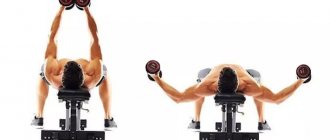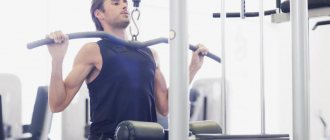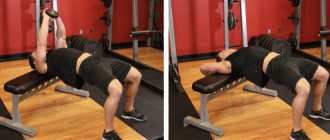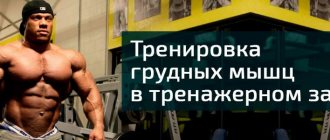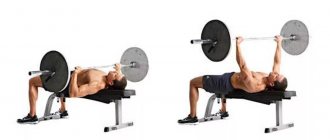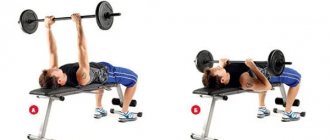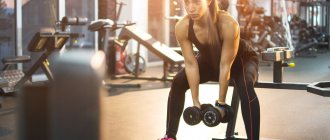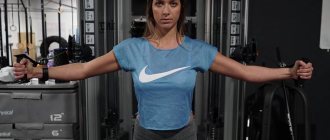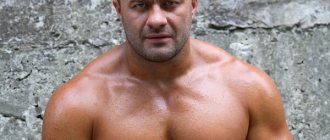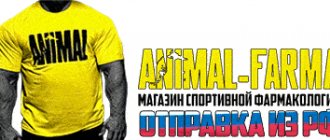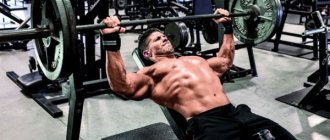The pectoral muscles (pectoral from the English pectoralis) are one of the main objects of training in strength sports, both for men and women. At first glance, they have a simple structure and function; up to 90% of the entire group is represented by the pectoralis major muscle. However, the thoracic region includes several components. Understanding their characteristics can make chest training as productive as possible.
The structure of the pectoral muscles
The entire area is represented by the following chest muscles:
- Large;
- Small;
- Serrated;
- Subclavian.
The latter is the smallest in volume in the group, therefore almost no attention is paid to it in sports.
If we take into account the anatomy of the pectoral muscles, the large one occupies almost the entire volume of the group. The structure of this pectoral muscle has a complex structure. The muscle fibers are directed in different directions, therefore, to work out the entire surface, a load is required from different angles. The pectoralis major starts from:
- medial part of the clavicle;
- anterior wall of the rectus abdominis muscle;
- anterior surface of the sternum and costal cartilages.
Attaches to the crest of the greater tubercle of the humerus and the edge of the deltoid. Structurally, it is the largest muscle of the chest, which covers the area in the form of a shield or solid plate.
The pectoralis minor muscle is the second largest in the group. It lies under the large one and starts from 2 to 5 costal teeth. Attached to the scapula (coracoid process).
The serratus pectoralis muscle is anatomically located away from the main group. Like the small one, it starts from the ribs and is attached to the shoulder blade.
The subclavian starts from the 1st rib (cartilaginous part) and is attached to the lower part of the clavicle.
In addition to the main group, the rib muscles are distinguished. They belong to infants and are divided into:
- superficial chest muscles;
- as well as the deep muscles of the chest.
They are responsible for inhalation and exhalation; they usually do not need additional training.
Training mistakes
Exercises for the chest muscles have gained widespread popularity due to their effectiveness. But at the same time, people make typical mistakes that hinder the growth of the strength of this group:
- Mistake #1. Race for the scales. Despite the fact that the pectoral muscles respond well to working with heavy weights, it is worth remembering that in all basic exercises, the triceps and deltoids take on a decent portion of the load. Therefore, it is better to work the chest with perfect technique and slightly lighter weights.
- Mistake #2. Using only the bench press. Traditionally it is considered that this is the best exercise for the sternum muscles. However, this is not quite true. Ideally, supplement it with exercises and be sure to work on benches with different inclinations.
- Mistake #3. Chop. It helps you lift weights easier and therefore do more repetitions. However, when beating, the impulse component reduces the load on the pectoral muscles and increases the risk of sprains and injuries.
- Mistake #4. Exercise machines are for weaklings. Exercise machines have a fixed, unnatural range of motion, which is why many people consider them ineffective for working out. This is not true. With proper work on the machines, you can improve the performance of a lagging muscle group or concentrate your attention on a separate group. Do them after the main basic presses, but before flyes.
- Mistake #5: Split training with your back or legs. The basic three-piece “press-dead-squat” is only suitable for acquiring basic indicators or for training in powerlifting. In the case when you need to work exclusively on the pectoral muscles separately, the general fatigue accumulated due to deadlifts and squats will not allow you to perform a set of chest exercises with maximum impact. The best option is to combine it with triceps or biceps.
Basic functions of the chest muscles
In most cases, the functions of the pectoral muscles are duplicated, the entire array works as a single whole. Therefore, in sports, the entire group is linked by the function of the pectoralis major muscle, without isolating the rest separately.
Pectoralis major muscle:
- lowers his arms to his body from the top position;
- pronation (turning inward) of the hand;
- flexion of the arm (responsible for the clavicular part);
- assistance with inhalation and pulling the body (for example, while climbing a rope).
Pectoralis minor muscle:
- provides movement of the scapula;
- pulls the scapula up and down;
Also, the functions of the pectoralis minor muscle include assisting in breathing with fixed arms.
Serratus muscle:
Rotating and pushing the shoulder blade forward.
Subclavian muscle:
Provides downward movement of the collarbone.
In men and women, the chest muscles anatomically have almost no differences, with the exception of some features. The only visual difference is the mammary glands. And also in the anatomy of the pectoral muscles of men there is a predominance of fast muscle fibers. In women, the ratio is shifted towards slow fibers.
Training program
It is better to train the pectoral muscles in several stages. For each stage, use your own training program. How to pump up the muscles of the sternum without injury and as quickly as possible, we will consider below.
Program No. 1 – pre-training (at home)
If you have never done strength sports and are in poor physical shape, it is advisable to devote a month or two to home exercises. As in the case of kettlebell lifting, independent exercises prepare the ligaments and tendons for the upcoming loads. In addition, working with your own weight reduces the risk of injury.
Typical program:
| Exercises | Number of approaches and repetitions |
| Push-ups with wide arms | 4x10-15 |
| Bend-over push-ups | 4x8-12 |
| Plyometric push-ups | 4x8-12 |
| Bend-over push-ups | 3 to maximum |
Program No. 2 – split “pectorals + triceps”
When visiting a fitness club for the first time, a beginner should train according to the fullbadi scheme, when the whole body is pumped in one day. After a few months, as your performance increases, you can switch to splitting - dividing muscle groups by day. In this case, the chest is most often combined with the triceps, since it actively works in almost all chest movements.
| Exercises | Number of approaches and repetitions |
| Bench press on a horizontal bench | 4х12,10,8,6 |
| Incline Dumbbell Press Up | 4x10-12 |
| Dips | 3x12-15 |
| Incline bench fly | 3x12 |
| French bench press | 4x12 |
| Crossover row with triceps rope | 3x15 |
Program No. 3 – separate chest day
An option for experienced athletes who allocate a separate day for each muscle group.
| Exercises | Number of approaches and repetitions |
| Incline Bench Press | 4x10-12 |
| Dumbbell Bench Press | 4x10-12 |
| Dips with extra weight | 3x10-12 |
| Bench press | 3x12 |
| Information in the crossover | 3x15 |
Recipes for healthy eating
Cauliflower baked in the oven - dietary recipe
- 6.2 Proteins
- 10.9 Fats
- 22.1 Carbohydrates
- 201.4 kcal
30 min.
- #vegetarian dish
- #second course
- #garnish
- #dietary
- #for vegans
- #baking
- #lemon
- #low calorie
- #dinner
- #vegetables
- #snack
- #vegetable oil
- #soy sauce
- #spices
- #dinner
- #cauliflower
- #garlic
Other recipes
The best exercises for chest
- Bench press - works almost the entire shoulder girdle and arms.
- Bench press at an angle - focus on the upper chest.
- Dumbbell press (on a straight and incline bench) - duplicates the barbell press, but it loads the pecs to a greater extent.
- Lying dumbbell flyes.
- Pullover – loads the entire pectoral mass, especially the serratus muscle.
- Dips – focus on working the lower part of the pecs.
- Bringing the arms together in a crossover - working out the lower and inner parts.
Respiratory muscles
External and internal intercostal muscles
There are two types of intercostal muscles: internal and external. The external ones are located under the superficial muscles, filling all the intercostal spaces of the anterior sections, in a more understandable language, these muscles are located directly on the ribs themselves in front, behind and between them. They are not located strictly vertically, but at an angle towards the chest. The external muscles begin from the lower edges of the upper rib and end at the upper edges of the underlying ribs. Main functions : raise the ribs, providing inspiration.
The internal intercostal muscles are also located between the ribs, but they are located inside the chest. In the area where cartilage is located, they are absent; there they are replaced by intercostal membranes. Main functions: lower the ribs and participate in the act of calm breathing. When breathing intensely, for example while running, other chest muscles are activated to exhale: the major and minor muscles, the trapezius, the neck and the abs.
Subcostal muscles
They are the deepest muscles of the chest, located below the internal intercostal muscles, attached to the ribs from below, on the inside. They differ from the intercostal muscles in that their bundles are thrown over one rib, reminiscent of basket weaving. Main functions: participate in the breathing process (exhalation). May raise the ribs during intense breathing.
Diaphragm
One of the unpaired muscles (does not have a pair). Separates the chest and abdominal cavities from each other, resembles a jellyfish in shape, begins along the entire circumference of the lower ribs, tapering towards the center and passes into the tendons. Main functions: during contraction, the diaphragm increases the volume of the chest and inhalation occurs. When relaxed, it takes on a convex shape (resembling a sphere). As a result, the chest shrinks and exhalation occurs. Also, involuntary jerky contractions lead to hiccups.
The relationship between the physiological characteristics of the body and training
Professionals classify the chest according to appearance into two options.
- The first group includes men who have a flat chest, which makes their shoulders look broader. With this structure, it is easy for them to develop their chest muscles while standing with loads, on a crossover with blocks or on weight machines. But performing bench presses for them will be problematic.
- The second group contains men who have a laterally flattened chest, making it look like a “wheel.” Bench presses will be easier for them due to anatomical advantages in strength and a short trajectory of movement.
This is where we will stop and interrupt our story to advise you.
Summer is ahead! It's time to relax in nature, near the sea or river! Of course, now is the time to pump up your muscles and acquire an attractive male torso by summer.
Then go ahead!
Our advice! It’s better to start training in the gym under the guidance of an experienced trainer. At the same time, he will select for you the correct technique and optimal weights for lifting to ensure your safety.
Exercise combinations
We have given you an example of 6 different exercises for pumping up the upper chest area. Naturally, there is no need to do them in one day. When you work “to failure” you will simply become overtired, and there is no point in such training. Therefore, to conscientiously pump up your upper chest, choose three exercises per workout:
- Bars, angled press, angled fly.
- Angle press, dumbbell press, dumbbell fly.
- Press, fly, crossover.
Do push-ups on your own to pump up your chest at home.
Don't forget to do warm-up sets! By the way, you can alternate dilutions of 30 and 45 degrees.
How to pump up a girl's pectoral muscles. General recommendations and necessary equipment
Before you enthusiastically search the Internet for a suitable training program, answer yourself honestly: are you ready to work for 2-3 months before the results become noticeable? Usually, girls' pectoral muscles are very weak, and it is simply impossible to pump them up without long-term work. Moreover, you need to give your all in every workout, thoughtfully working out the upper body.
A common problem among the female population is the belief that point loads will be enough. But in fact, breasts will look truly gorgeous only if you combine exercises for the arms, back, abs and pectoral muscles to evenly develop the muscles of the torso. A comprehensive workout lasting 40-60 minutes is optimal, before and after which you need to spend 15 minutes warming up and stretching. The frequency of classes is 2-3 times a week.
To pump up your pectoral muscles, you will need:
- a special sports bra or top with firm elastic cups of your size (a large one will not be able to properly support the breasts, a small one will compress);
- exercise mat;
- dumbbells (1-3 kg);
- small hand ball;
- female expander.
Shape of the pectoral muscles. Pectoral muscles. We all have completely different shapes of our pecs.
Let's look at some features of the pectoral (pectoral) muscles: there are muscles, the lower edge of which is a straight line; others are distinguished by the rounded shapes of each individual pectoral muscle at the bottom.
But, no matter what type of muscle you have, this position cannot be changed. However, the mass of each individual section of the pectoral muscles can be changed to a greater or lesser extent. Upper area of the pectoral muscles.
The upper pecs are best built by all forms of incline bench presses. Set the back of the bench at an angle of 35 to 50. A steeper angle will work the uppermost bundles of the pectoral muscles. The lower the inclination of the bench, the lower the area of the pectoral muscles the impact of this exercise moves to.
Experiment with a variety of exercises, including incline barbell presses, incline dumbbell presses, and incline dumbbell flyes or pulleys.
Internal parts of the pectoral muscles.
Today, bodybuilders want to demonstrate powerful development of the pectoral muscles in the area adjacent to the sternum (breastbone). Additionally, when the inner parts of the pectoral muscles are at their maximum development, the striations of the overall muscle are more clearly visible, and you know what an impression it makes.
The inner pecs are usually very difficult to train, but today we have access to specialized machines that include an arm crossover, a machine that works the inner pecs by crossing the arms in front of the torso. the final stage of each repetition. There is also a “Peck-Deck” machine, when training on which the vertical forearms are brought towards each other in each repetition.
External parts of the pectoral muscles.
The outer parts of the pectoral muscles, as a rule, fall into oblivion more often than others during training, and most athletes (both men and women) need accentuated development of this muscle group. Why? Simply because when you build strong outer pecs, you create a more tapered torso.
You create an additional visual illusion of width in the upper chest and shoulder girdle. Without the thick layers of muscle in the upper outer part of the chest, you take on the outline of a rib cage that appears to expand downwards.
The best exercises for the outer pectoral muscles are parallel bar push-ups (chin on chest, elbows out, legs together), wide-grip barbell bench press, and dumbbell flyes lying on a flat bench.
It's interesting to note that, along with the pelvic girdle muscles (glutes and upper thighs), the pecs are one of the most responsive and growing muscles. For this reason, everyone should be aware of the possibility of a problem - stretch marks on the skin. Just in case you are vulnerable to these “internal skin tears”, then do not combine high volumes of heavy chest exercises with a diet of high-calorie foods. Traces of skin stretch marks cannot be removed. They are the result of the fact that the skin does not have time to stretch following the increased development of muscle volume underneath it. Eating well, especially having the right balance of minerals, can help improve skin elasticity and health. The only solution to the problem of stretch marks that have already appeared is surgery, so your best defense against this not particularly pleasant picture is to take steps to prevent the marks from occurring.
Many people want to know if they can increase the capacity of their chest. Chest circumference, of course, increases as you gain muscle mass, but you will help matters a little if you practice doing pullovers with straight arms (using a light barbell), or lying across a high bench with a dumbbell. Traditionally, the old, reliable school of physical education (that’s what bodybuilding was called in its early years) argued that chest volume could be increased by alternating sets of so-called “Breathing” squats, performed in a high number of repetitions (20-30), and a barbell, or you take it yourself from the racks at the head of the training bench. Lower the bar to the nipple area on your chest and squeeze until your arms are straight. In this case, the elbows should move to the sides, as far from the torso as possible. Lower and repeat. Try not to let the bar bounce off your chest (do not bounce), which can damage the very sensitive nerve endings under your rib bone. This exercise can also be performed with dumbbells.
Bringing the elbows forward on the peck-dec-simulator.
You will need to use a special peck-dec-simulator to perform this exercise. Hold the handles of the machine firmly, starting the movement with your elbows out to the sides. Concentrate all your attention on contracting your pectoral muscles and bring your elbows forward. Return them to the starting position and repeat. This is an isolation exercise for the pectoral muscles, and it works the entire pectoral muscle area.
Lying arm raises.
Lie on your back on a horizontal bench. You hold two dumbbells (or the handles of the lower cables on a crossover machine) in straight arms in front of you, above your head. Slowly spread your arms out to the sides of your body as low as possible (shoulders should be perpendicular to your torso), bring them up and forward and repeat. During the entire exercise, the arms at the elbow joints should be slightly bent, but their position should not change during the entire exercise. Imagine that both arms are encased in a plaster cast. As your experience and strength increase, this exercise can be used with very decent weights. The exercise can also be performed on an incline bench.
Wide parallel bars push-ups.
Vine Gironda said that the most massive pectoral muscles he had ever seen in his life belonged to one athlete - a strongman of yesteryear named Bill Trumbo. “He never did any Bench Presses,” said Vina, “but only Dips.”
Gironda's parallel bar style recommendations are unique and clearly effective in the sense that they develop the pectoral muscles in the outer lobes (outer edge) and this gives an overall impression of chest width, emphasizing the overall tapering of the torso.
Your hands should be placed on the parallel bars so that there is a distance between them of at least 75-80 cm; if you are a tall person, you need to increase this distance to 85 cm. In the lowering phase of push-ups, it is important to move your feet forward and place your chin on your chest , and spread your elbows away from your torso. This movement is very different from the traditional style of triceps push-ups, which, although performed on parallel bars, require the elbows tucked into the torso, the feet pointed back, and the head raised up.
Stretch your pectoral muscles as much as possible at the bottom of the movement, and then rise up. After just a few repetitions of this exercise, you will feel the power of its effect on the pectoral muscles.
Bench press on an incline bench.
Hold two dumbbells or a barbell with your arms straight above your head while lying on an incline bench. Usually the back of the bench is located at an angle of 45.
However, more pectoral muscle mass comes into play when the bench is positioned at a more acute angle, say around 35°. In my opinion, this angle is ideal. Keeping your arms in a position where your elbows are pointing out to the sides and back and your palms are facing forward, lower the weights down, press again and repeat. You can also do this exercise with a barbell on a Smith machine.
Pullover with a dumbbell.
Some may argue with me - they say that this exercise is mainly intended to work the latissimus muscles, not the pectoral muscles. Yes, it works some of the lats, but this exercise is more often appreciated for its contribution to chest expansion and targeting the upper pecs. Start by lying across the training bench, resting on it only with your upper back in the shoulder blade area.
Hold the dumbbell with both hands overhead so that it is securely and comfortably in an upright position (the palms of both hands should be placed on the inner surface of the discs at the top end of the dumbbell. Slowly lower the dumbbell behind your head, keeping your arms slightly bent at the elbows. Allow your chest cage to fully stretch, and then return the dumbbell to the starting position with your arms straight above your head. You can replace the dumbbell with a light barbell if you like this variation. The grip width of the barbell should be equal to the width of your shoulders.
Crossing arms on blocks (on a crossover - car).
Most gyms have something called a crossover machine, although having one in your home gym may be considered a luxury. Properly used cross-arms on blocks can allow you to thoroughly work the central areas of the pectoral muscles, which are very difficult to “reach” with exercises on any other training equipment, with the possible exception of a peck-deck machine.
Hold the handles of the block device in the initial position of a certain “Cross”, and then, leaning slightly forward, bring your hands to a position in front of the body, almost closing them. Your elbows should be held in a slightly bent position (again, think of them as if they were in a plaster cast. Experiment with different torso and arm positions to direct maximum force to the area of the pectoral muscles that you want to maximally load. Robert Kennedy, excerpts from the book “Cool Bodybuilding.”
Possible diseases and pathologies
Poor sitting position, which negatively affects the posture of the upper body, negatively affects the functioning of the pectoralis minor muscle. Postures that involve long periods of extension of the scapula cause it to contract, holding the bone in an undesirable position.
What influences the development of pathologies:
- Chest injury.
- Major or minor fracture, deformation of the upper ribs.
- Using crutches for long periods of time.
- Hyperventilation or heavy breathing.
- Long-term mental stress.
- Carrying a heavy backpack or other heavy objects for a long time.
- Holding the head forward for a long time in a position with a lowered chest, characteristic of people working at a computer.
- Previous or irregular heart pain due to a heart attack or angina.
The pectoralis minor muscle (the anatomy of which is constantly being studied) may show signs of disorders and abnormalities.
Therapy depends on the severity of the pain and the area of injury, but the treatment process is often conservative:
- Rest. A patient suffering from major or minor muscle pain should avoid physical activities that worsen the condition and increase the pain. Rest allows you to repair any minor damage through your own immune system.
- Physiotherapy. This is the most important part of the treatment for pain in the pectoral muscles. In most cases, doctors prescribe physical therapy. During the recovery period, stretching, light resistance, and strength training are helpful.
- Anesthesia. Ice packs are applied for immediate relief, reducing inflammation, and reducing swelling. In some situations, mild analgesics are used.
- Surgery.
Wright's syndrome
The term "syndrome" is used in medicine and surgery to refer to a group of abnormalities that repeatedly occur together. Since the pectoralis minor muscle connects the scapula to the chest and at the same time is close to nerves and blood vessels, the term pectoralis minor syndrome implies:
- abnormal scapula mechanics;
- abnormalities affecting adjacent nerves and vessels.
Minor abnormalities of the chest can lead to compression of nerves and blood vessels, as well as pain in the scapula area.
Pectoralis minor syndrome is compression of the brachial plexus between the uncinate process on the top of the scapula and the contracted pectoralis minor muscle. This occurs due to a tight muscle that puts pressure on the neurovascular structures between it and the chest.
A tight and shortened muscle also causes the rounded shoulder blade to straighten. Weak scapular retractors (the muscles that pull the shoulder blades toward the back) contribute to this posture because they lack the strength to resist the pull of tight pectoral muscles.
Wright's syndrome or tunnel syndrome develops with hypertonicity and muscle shortening. With maximum abduction of the shoulder, the pectoral muscle presses the vascular and nerve bundles to the coracoid process of the scapula.
Sometimes there is compression of the subclavian artery, the veins that pass under the place of attachment of the pectoral muscle to the coronoid process.
Microtrauma, repeated many times, causes vascular spasm and maintains irritation of the trunks of the brachial plexus.
Classification
There are four forms of thoracic outlet syndrome:
- Anterior scalene syndrome.
- Costoclavicular syndrome.
- Pectoralis minor syndrome.
- Cervical rib syndrome.
The upper opening of the chest (aperture) connects the neck and chest. This area is considered the "outlet" where arteries carry blood from the chest to the arm to nourish the tissues of the upper limb, and motor neurons carry motor innervation from the chest to the arm to control contraction of the muscles of the upper limb.
However, this condition is sometimes called thoracic inlet syndrome because veins in this area carry blood and sensory neurons transmit innervation to the chest from the arm. This concept is used for any compression in this area, regardless of whether the compressed structures are exiting or entering.
Symptoms and signs
General characteristics of the syndrome include:
- the head is constantly or often in a forward position;
- increased cervical lordosis;
- increased thoracic kyphosis;
- raised, elongated or rounded shoulders when the muscles are in a continuous state of stretch;
- the visible part of the scapula protrudes instead of lying flat (wing of the scapula).
The misshapen muscles associated with the syndrome place stress on surrounding muscles, tendons, bones and joints, causing most people to develop symptoms:
- headache;
- pain and tightness in the chest, neck;
- pain in the upper back, especially in the shoulders;
- soreness in the jaws, shoulder blades;
- fatigue;
- limited range of motion of the neck and shoulders;
- numbness, tingling in the forearms;
- compression of the pectoral girdle;
- feeling of pain coming from the inside of the elbow;
- pain that occurs inside the hand and spreads to the middle, ring and little fingers;
- numbness of the forearm, hand and fingers;
- Difficulty while sitting, driving a car, or stretching your arm forward and upward.
Causes
Shortening of the small muscle or tonic tension is most often the cause of neurovascular disorders occurring due to compression of the neurovascular bundle. Various movements can cause the syndrome, but in most cases it develops due to poor posture when the head is stretched forward for a long time.
Reasons influencing the anomaly:
- Muscle injury. After healing, it became shorter, covered with scars and lost elasticity.
- Developed hypertrophy, which is especially typical for athletes.
- Congenital anomaly of the organ.
- Prolonged use of the hand during monotonous work, for example, among carpenters and construction workers. This is also typical for office workers who slouch at the computer for long periods of time. By holding your arms in front with your elbows bent, they narrow the space where the arteries and nerves pass. Over time, the incorrect position leads to increased muscle hypertonicity, shortening of the muscle, in the process of adapting to the new position of the scapula.
Treatment methods
Chest stretching is one of the main treatment methods because it reduces spasms of the pectoralis minor muscles.
Pectoralis minor muscle
Treatment methods:
- Massage, manual therapy. The procedures work on the muscles, breaking down the scar tissue between layers of muscle, muscle fibers, tendons and fascial restrictions of the neurovascular bundle.
- Laser treatment. Accelerates healing and regeneration of nerves from damage caused by chronic compression.
- Paraffin treatment. Used for severe persistent pain.
In some cases, novocaine blockade is used. If there is no result after conservative treatment, surgery is recommended - intersection of the tendons of the pectoralis minor muscle.
